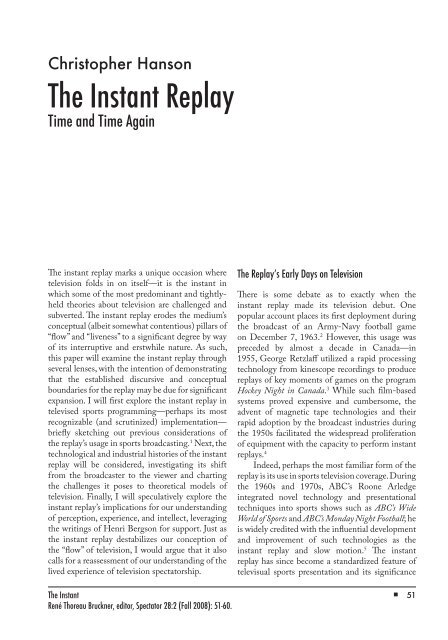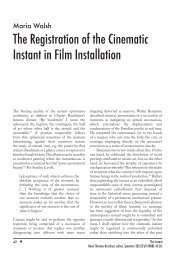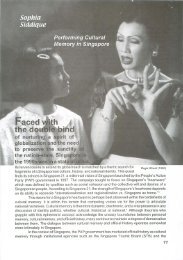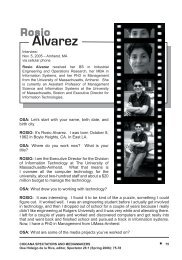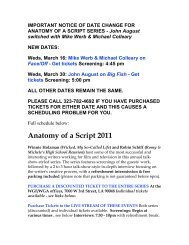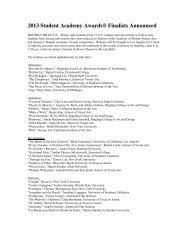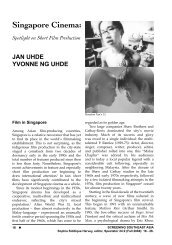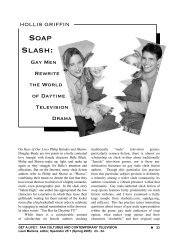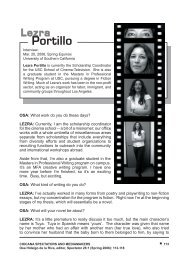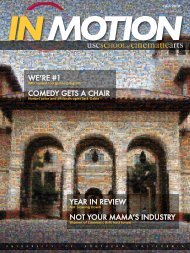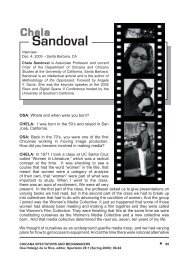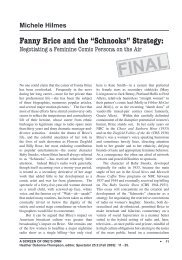The Instant Replay - USC School of Cinematic Arts - University of ...
The Instant Replay - USC School of Cinematic Arts - University of ...
The Instant Replay - USC School of Cinematic Arts - University of ...
You also want an ePaper? Increase the reach of your titles
YUMPU automatically turns print PDFs into web optimized ePapers that Google loves.
Christopher Hanson<br />
<strong>The</strong> <strong>Instant</strong> <strong>Replay</strong><br />
Time and Time Again<br />
<strong>The</strong> instant replay marks a unique occasion where<br />
television folds in on itself—it is the instant in<br />
which some <strong>of</strong> the most predominant and tightlyheld<br />
theories about television are challenged and<br />
subverted. <strong>The</strong> instant replay erodes the medium’s<br />
conceptual (albeit somewhat contentious) pillars <strong>of</strong><br />
“flow” and “liveness” to a significant degree by way<br />
<strong>of</strong> its interruptive and erstwhile nature. As such,<br />
this paper will examine the instant replay through<br />
several lenses, with the intention <strong>of</strong> demonstrating<br />
that the established discursive and conceptual<br />
boundaries for the replay may be due for significant<br />
expansion. I will first explore the instant replay in<br />
televised sports programming—perhaps its most<br />
recognizable (and scrutinized) implementation—<br />
briefly sketching out previous considerations <strong>of</strong><br />
the replay’s usage in sports broadcasting. 1 Next, the<br />
technological and industrial histories <strong>of</strong> the instant<br />
replay will be considered, investigating its shift<br />
from the broadcaster to the viewer and charting<br />
the challenges it poses to theoretical models <strong>of</strong><br />
television. Finally, I will speculatively explore the<br />
instant replay’s implications for our understanding<br />
<strong>of</strong> perception, experience, and intellect, leveraging<br />
the writings <strong>of</strong> Henri Bergson for support. Just as<br />
the instant replay destabilizes our conception <strong>of</strong><br />
the “flow” <strong>of</strong> television, I would argue that it also<br />
calls for a reassessment <strong>of</strong> our understanding <strong>of</strong> the<br />
lived experience <strong>of</strong> television spectatorship.<br />
<strong>The</strong> <strong>Instant</strong><br />
René Thoreau Bruckner, editor, Spectator 28:2 (Fall 2008): 51-60.<br />
<strong>The</strong> <strong>Replay</strong>’s Early Days on Television<br />
<strong>The</strong>re is some debate as to exactly when the<br />
instant replay made its television debut. One<br />
popular account places its first deployment during<br />
the broadcast <strong>of</strong> an Army-Navy football game<br />
on December 7, 1963. 2 However, this usage was<br />
preceded by almost a decade in Canada—in<br />
1955, George Retzlaff utilized a rapid processing<br />
technology from kinescope recordings to produce<br />
replays <strong>of</strong> key moments <strong>of</strong> games on the program<br />
Hockey Night in Canada. 3 While such film-based<br />
systems proved expensive and cumbersome, the<br />
advent <strong>of</strong> magnetic tape technologies and their<br />
rapid adoption by the broadcast industries during<br />
the 1950s facilitated the widespread proliferation<br />
<strong>of</strong> equipment with the capacity to perform instant<br />
replays. 4<br />
Indeed, perhaps the most familiar form <strong>of</strong> the<br />
replay is its use in sports television coverage. During<br />
the 1960s and 1970s, ABC’s Roone Arledge<br />
integrated novel technology and presentational<br />
techniques into sports shows such as ABC’s Wide<br />
World <strong>of</strong> Sports and ABC’s Monday Night Football; he<br />
is widely credited with the influential development<br />
and improvement <strong>of</strong> such technologies as the<br />
instant replay and slow motion. 5 <strong>The</strong> instant<br />
replay has since become a standardized feature <strong>of</strong><br />
televisual sports presentation and its significance<br />
51
insTanT REplay<br />
has rapidly grown since its debut, to such an extent<br />
that the replay has now been incorporated into the<br />
rules <strong>of</strong> play <strong>of</strong> several pr<strong>of</strong>essional and collegiate<br />
sports. Officials may review decisions made in “real<br />
time” by watching recorded footage <strong>of</strong> previous<br />
plays, allowing them to reverse or revise decisions<br />
made on the field. While NFL rules since 1986<br />
allow <strong>of</strong>ficials to review plays by examining<br />
instant replays <strong>of</strong> recent game events at their<br />
discretion, rule changes made in 1999 also grant<br />
the coach <strong>of</strong> each team the authority to request<br />
a set number (currently two per half ) <strong>of</strong> <strong>of</strong>ficial<br />
reviews <strong>of</strong> questionable onfield<br />
calls. 6 <strong>The</strong>se requests for<br />
replays are at the head coaches’<br />
discretion, and the requesting<br />
team is penalized if the initial<br />
ruling on the field is not<br />
overturned. NFL teams now<br />
employ personnel dedicated to<br />
constantly scrutinizing instant<br />
replays <strong>of</strong> each play during a<br />
game in order to minimize<br />
risk <strong>of</strong> penalty. As such, the<br />
proper usage <strong>of</strong> the instant<br />
replay has become an essential<br />
strategic element to play itself<br />
<strong>of</strong> NFL games—and their<br />
play is increasingly marked<br />
by interruption more than<br />
continuity.<br />
<strong>The</strong> viewer’s temporal<br />
experience <strong>of</strong> NFL games, as<br />
well as other sporting events,<br />
has been similarly fractured<br />
by the replay. As previously noted, broadcasting<br />
networks have long employed the instant replay to<br />
accentuate specific sequences in sporting events;<br />
these replays <strong>of</strong>ten occur outside <strong>of</strong> the game time<br />
<strong>of</strong> the depicted event. That is, the game clock <strong>of</strong><br />
a given sporting event is <strong>of</strong>ten paused while the<br />
replay is shown both on television screens at<br />
home and on large screens in the stadium. 7 Thus<br />
the viewer’s temporal experience <strong>of</strong> the sporting<br />
event is quite distinct from the game clock <strong>of</strong> the<br />
event itself—as time continues for the spectator<br />
during these replays, it freezes in the game. In the<br />
NFL (as well in other sports), the replay therefore<br />
ruptures the analogous temporalities between the<br />
52 FALL 2008<br />
sport and its spectatorship alike as well as further<br />
differentiating the two from one another. However,<br />
despite disrupting both the game’s flow <strong>of</strong> play<br />
and its spectatorial temporalities—and further<br />
detaching the game time from the spectator’s<br />
experience <strong>of</strong> the game—the instant replay has<br />
become a requisite component <strong>of</strong> both the play<br />
and spectatorship <strong>of</strong> sport.<br />
As such, sport has become a natural locus<br />
for research on—and theoretical investigation<br />
<strong>of</strong>—the instant replay. Margaret Morse analyzes<br />
the differences between the experience <strong>of</strong> a<br />
stadium spectator and that <strong>of</strong><br />
a television viewer. She notes<br />
the use <strong>of</strong> replay and multiple<br />
cameras to induce temporal<br />
alteration and compression<br />
<strong>of</strong> space, respectively. 8 Garry<br />
Whannel discusses not only<br />
the transformation <strong>of</strong> time<br />
alluded to by Morse, but also<br />
what he terms the “spatial<br />
fragmentation” <strong>of</strong> sporting<br />
events, which television<br />
producers craft from their use<br />
<strong>of</strong> multiple camera angles and<br />
levels <strong>of</strong> zoom. 9 He suggests<br />
that this fragmentation is<br />
a necessary byproduct <strong>of</strong><br />
television’s transformation<br />
<strong>of</strong> sport into spectacle. This<br />
would seem to indicate that<br />
the use <strong>of</strong> crosscutting to imply<br />
the simultaneity <strong>of</strong> disparate<br />
actions, when combined with<br />
instant replay, redoubles the transformation <strong>of</strong><br />
time and space. Barbra Morris, in her analysis <strong>of</strong><br />
pr<strong>of</strong>essional wrestling and basketball, argues that<br />
the replay serves as a “parenthetical phrase” in the<br />
liveness <strong>of</strong> television—it is an aside which functions<br />
as a means <strong>of</strong> both appreciation and analysis <strong>of</strong> a<br />
current text. 10 As Morris argues, the instant replay<br />
operates as a form <strong>of</strong> “descriptive repetition”<br />
which forces the television viewer to shift from<br />
merely watching television to a more active mode<br />
<strong>of</strong> engagement. 11 Fig. 1. an nFl referee reviews a controversial<br />
decision by instant replay.<br />
For Morse, Whannel, and<br />
Morris, then, the instant replay marks a form <strong>of</strong><br />
fragmentation—be it temporal, spatial, or textual.<br />
However, despite this established theoretical
focus on sport as a means to examine the instant<br />
replay, its historical and technological development<br />
and adoption demonstrate the replay’s measured<br />
reach into other discursive dominions. In asserting<br />
that “[m]ost viewers probably associate replay<br />
with ‘non-serious’ content on television,” Morris<br />
suggests that the technique is generally leveraged<br />
during programming considered trivial and thus<br />
passes as insignificant. I would argue, however,<br />
that the replay has become an indispensable<br />
component in our experience <strong>of</strong> television and<br />
other media. To examine its influence today, it<br />
is useful to briefly consider the historical and<br />
industrial conditions which first engendered its<br />
rapid adoption into broadcasting. In conjunction<br />
with the rapid expansion in television broadcasting<br />
in the 1950s, a correlating need for content to fill<br />
the airwaves emerged. <strong>The</strong> expenses demanded<br />
by live broadcasting restricted the operation <strong>of</strong><br />
stations to limited hours and similarly restrained<br />
the capacity <strong>of</strong> networks to broadcast across time<br />
zones. Aaron Nmungwun points to the research<br />
in recording technologies which sought to address<br />
a number <strong>of</strong> the problems inherent to television,<br />
including seeking “to delay broadcast <strong>of</strong> certain<br />
presentations to a more convenient time” (namely,<br />
to account for the 3 hour time difference between<br />
the East and West Coast markets); to “eliminate<br />
labor costs for night work”; to extend network<br />
programming to affiliates not connected by cable<br />
or radio relay; and for “postmortem” purposes to<br />
allow producers to see complete, finished work<br />
prior to its transmission. 12<br />
Facilitating the introduction <strong>of</strong> the instant<br />
replay, the rapid growth, expansion and proliferation<br />
<strong>of</strong> commercial television outpaced the fairly slow<br />
and limited technique <strong>of</strong> recording television<br />
with film. 13 Instead, the broadcast industry turned<br />
to the successful and already established use <strong>of</strong><br />
magnetic tape for recording audio and adapted<br />
the technology for the purposes <strong>of</strong> recording both<br />
sound and image. As a result <strong>of</strong> this research push,<br />
videotape recorder models began to reach network<br />
broadcasters in the mid-1950s. CBS became the<br />
first network to leverage the new technology for<br />
a time-delayed West Coast broadcast <strong>of</strong> its news<br />
program, “Douglas Edwards and <strong>The</strong> News” on<br />
November 30, 1956. 14<br />
Thus market and labor conditions in the<br />
THE insTanT<br />
hAnSon<br />
Fig. 2. november 24, 1963. <strong>The</strong> shooting <strong>of</strong> lee Harvey Oswald.<br />
television broadcasting industry in the 1950s<br />
encouraged the adoption <strong>of</strong> magnetic tape<br />
technologies, resulting in their widespread<br />
deployment and adoption by the early 1960s.<br />
Although it is most <strong>of</strong>ten associated with sport<br />
(and as indicated earlier, it was first implemented<br />
during the broadcast <strong>of</strong> sporting events), Erik<br />
Barnou supplies an interesting alternative for<br />
the popularization <strong>of</strong> instant replay, tracing its<br />
widespread use through the reporting <strong>of</strong> the<br />
murder <strong>of</strong> Lee Harvey Oswald in late 1963. 15 <strong>The</strong><br />
incessant replaying <strong>of</strong> this shocking event attests to<br />
the pervasiveness <strong>of</strong> magnetic technologies in news<br />
broadcasting as early as 1963. Moreover, the fact<br />
that this event is roughly concurrent with one <strong>of</strong><br />
the earlier sports-broadcast uses <strong>of</strong> replay indicates<br />
that the instant replay resonated culturally far<br />
beyond the sports arena.<br />
User-Controlled <strong>Replay</strong><br />
Since the 1970s, a growing number <strong>of</strong> consumer<br />
electronic products have placed increasingly<br />
greater degrees <strong>of</strong> replay control into the hands<br />
<strong>of</strong> the viewer, effectively transforming viewer into<br />
user and forever altering the experience <strong>of</strong> the<br />
moving image. As Anne Friedberg has indicated,<br />
the Video Cassette Recorder (VCR)’s capacity for<br />
playback, “significantly altered the terms <strong>of</strong> both<br />
televisual and cinematic viewing.” 16 By affording<br />
the user the power to record and playback video,<br />
Friedberg contends that the VCR introduced the<br />
potential to ‘time-shift’ by allowing the user to<br />
watch what she chooses at a time <strong>of</strong> her choosing<br />
53
insTanT REplay<br />
and to re-watch films and programs as <strong>of</strong>ten as<br />
she likes. This capacity for active control <strong>of</strong> prerecorded<br />
content (be it televisual or filmic) allowed<br />
users the capability to instigate their own replays;<br />
as such, the VCR represents an early instance <strong>of</strong><br />
user-initiated and -controlled replay.<br />
Vivian Sobchack argues that the technological<br />
innovations <strong>of</strong> film, video tape and electronic media<br />
have also effected a greater cultural and perceptual<br />
shift:<br />
…although relatively novel as<br />
“materialities” <strong>of</strong> human communication,<br />
cinematic and electronic media have<br />
not only historically symbolized but also<br />
historically constituted a radical alteration<br />
<strong>of</strong> the forms <strong>of</strong> our culture’s previous<br />
temporal and spatial consciousness and<br />
our bodily sense <strong>of</strong> “presence” to the<br />
world, to ourselves and to others. 17<br />
Sobchack argues that these media forms have<br />
forever changed our understanding not only<br />
<strong>of</strong> media, but also <strong>of</strong> ourselves. Similarly, these<br />
comparatively nascent forms both reflect and<br />
effect significant shifts in aspects <strong>of</strong> our perceptual<br />
recognition and cognitive processing <strong>of</strong> space<br />
and time. As Sobchack contends, cinematic and<br />
electronic media have transformed not just our<br />
sense <strong>of</strong> presence, but our sense <strong>of</strong> presence “to<br />
the world.” I would argue that this shifting sense<br />
<strong>of</strong> presence is ongoing: as technologies such as<br />
the instant replay allow us greater—and more<br />
precise—control over our experience <strong>of</strong> media, they<br />
similarly alter our understandings <strong>of</strong> materiality<br />
Fig. 3. Detail <strong>of</strong> a TiVo controller with instant replay button.<br />
54 FALL 2008<br />
and bodily presence.<br />
In her book Death 24x a Second, Laura<br />
Mulvey similarly suggests that the ability to<br />
control (specifically to pause with precision)<br />
both the image and story afforded by new media<br />
technologies such as DVDs and video recorders<br />
has fundamentally transformed our experience<br />
<strong>of</strong> film. 18 Mulvey reasons that the “cohesion <strong>of</strong><br />
narrative” <strong>of</strong> film is subjected to undue pressures<br />
by newer technologies which allow viewers to<br />
experience films in settings and under conditions<br />
quite removed from traditional theatrical exhibition<br />
practices (that is, viewers may no longer be in a<br />
darkened room and may be subject to any number<br />
<strong>of</strong> external distractions). In addition to engendering<br />
potentially distractional environments, Mulvey<br />
asserts that “digital spectatorship also affects the<br />
internal pattern <strong>of</strong> narrative: sequences can be<br />
easily skipped or repeated, overturning hierarchies<br />
<strong>of</strong> privilege, and setting up unexpected links that<br />
displace the chain <strong>of</strong> meaning invested in cause<br />
and effect.” 19 Through their enhanced capacities<br />
for environmental flexibility and direct control <strong>of</strong><br />
previously linear narratives, digital technologies<br />
therefore impose irrevocable challenges to<br />
film’s traditionally dominant narrative mode <strong>of</strong><br />
sequentiality.<br />
As both Sobchack and Mulvey distinctly<br />
illustrate, it is clear that such technologies have<br />
familiarized spectators with the active manipulation<br />
<strong>of</strong> formerly linear narrative forms. Similarly,<br />
the appearance <strong>of</strong> devices such as Digital Video<br />
Recorders (DVRs)—TiVo, for example—has<br />
altered the role <strong>of</strong> the television in the home and<br />
has given the user a greater and more direct degree<br />
<strong>of</strong> control <strong>of</strong> replay. 20 That the TiVo is essentially<br />
a computer running the Linux operating system<br />
also provides a clear confirmation <strong>of</strong> Ellen Seiter’s<br />
prediction, in 1999, that “Television sets and<br />
computer terminals will certainly merge, cohabit,<br />
and coexist in the next century.” 21 William Boddy<br />
deftly investigates the early days <strong>of</strong> TiVo and<br />
other devices he terms PVRs (Personal Video<br />
Recorders) in his article “New Media as Old<br />
Media: Television.” Boddy suggests that DVRs/<br />
PVRs have “put into question traditional industry<br />
accounts <strong>of</strong> [television’s] role as signifier <strong>of</strong> national<br />
identity (i.e. the BBC), its ontology <strong>of</strong> liveness and<br />
photographic realism and its place as a consumer
product within the gendered household.” 22 <strong>The</strong>se<br />
devices actively and digitally record “live” television,<br />
allowing the user to instantly and precisely “pause”<br />
and “rewind” what she watches—much like a VCR,<br />
but without cumbersome electromagnetic cassette<br />
system used in the VCR. 23 <strong>The</strong> remote control<br />
for the TiVo includes an instant replay button,<br />
which will automatically “jump” the user back<br />
three seconds in her program; an advertisement<br />
for TiVo proclaims, “<strong>Instant</strong> replay in the palm <strong>of</strong><br />
your hand!” Similarly, digital cable services such<br />
as OnDemand allow users to stream or download<br />
programs from a central video computer server to<br />
their television and typically feature pause, rewind<br />
and fast-forward capability. All <strong>of</strong> these devices<br />
indicate a fundamental shift in both televisual and<br />
cinematic viewing practices, with replay as a central<br />
unifying and structuring logic. <strong>The</strong> instant replay<br />
has thus become a pivotal and implied component<br />
<strong>of</strong> our televisual experience; the capacity to<br />
actively and instantly rewind and replay portions<br />
<strong>of</strong> programming—even that which is “live”—is<br />
becoming both a familiar feature <strong>of</strong> the remote<br />
control and a requisite attribute <strong>of</strong> the server-based<br />
distribution <strong>of</strong> programming. This user-controlled<br />
deployment <strong>of</strong> programming has already begun to<br />
affect conventional broadcast strategies (such as<br />
HBO’s <strong>of</strong>fering <strong>of</strong> new episodes <strong>of</strong> shows a week<br />
before their broadcast) and may soon replace them<br />
altogether.<br />
<strong>The</strong>se recent digital technologies can be<br />
seen as direct challenges to Raymond Williams’s<br />
notion <strong>of</strong> “flow,” and their basis in early magnetic<br />
recording equipment indicates that a discussion <strong>of</strong><br />
the instant replay necessitates a re-consideration<br />
<strong>of</strong> Williams. In his seminal book Television:<br />
Technology and Cultural Form, Williams argues that<br />
the experience <strong>of</strong> television is characterized by the<br />
concept <strong>of</strong> flow. He suggests that early television<br />
broadcasts were marked by their intervallic<br />
nature—programming was broken up into discrete<br />
units that were <strong>of</strong>ten separated by pauses, during<br />
which time the station might broadcast a sound<br />
or image (such as the BBC’s spinning globe) to<br />
indicate that the broadcasting service remained<br />
active. 24 However, as a result <strong>of</strong> the commercial<br />
nature <strong>of</strong> much <strong>of</strong> more recent television<br />
broadcasting, television is marked by a continuous<br />
flow <strong>of</strong> images and sounds, as programming and<br />
THE insTanT<br />
hAnSon<br />
commercials stream in an uninterrupted fashion:<br />
“<strong>The</strong>re has been a significant shift from the concept<br />
<strong>of</strong> a sequence as programming to the concept <strong>of</strong><br />
sequence as flow.” 25 Thus what was once marked by<br />
distinct programming units with intervals is now<br />
an incessant stream. For Williams, “flow” names<br />
television’s sense <strong>of</strong> the perpetual now—its means<br />
<strong>of</strong> keeping the viewer’s attention from moment to<br />
moment and from program to program. Indeed,<br />
it might be considered the stream <strong>of</strong> television’s<br />
consciousness.<br />
Duration, Memory, and the <strong>Replay</strong><br />
Williams’s concept immediately recalls Henri<br />
Bergson’s notion <strong>of</strong> “duration” as our perceptual<br />
and intuitive experience <strong>of</strong> the continuous flow<br />
<strong>of</strong> time. While science and culture insist upon<br />
structuring and organizing time into discrete units<br />
such as seconds and years, Bergson instead asserts<br />
that our temporality is marked by its constancy and<br />
continuity: durée. Bergson’s theoretical approach<br />
is particularly constructive in an analysis <strong>of</strong> the<br />
replay as his examination <strong>of</strong> perceptual experience<br />
is uniquely analogous to several key considerations<br />
<strong>of</strong> television’s ontology. For instance, Herbert<br />
Zettl argues that the very essence <strong>of</strong> the physical<br />
apparatus <strong>of</strong> television is one <strong>of</strong> motion and a state<br />
<strong>of</strong> becoming; unlike film, television constantly<br />
rescans its image into the camera and redraws this<br />
image onto the screen:<br />
While in film each frame is actually a static<br />
image, the television image is continually<br />
moving, very much in the manner <strong>of</strong> the<br />
Bergsonian durée. <strong>The</strong> scanning beam is<br />
constantly trying to complete an always<br />
incomplete image. Even if the image on<br />
the screen seems at rest, it is structurally<br />
in motion. Each television frame is always<br />
in a state <strong>of</strong> becoming. While the film<br />
frame is a concrete record <strong>of</strong> the past, the<br />
television frame (when live) is a reflection<br />
<strong>of</strong> the living, constantly changing present.<br />
<strong>The</strong> live televised event and the event<br />
itself exist in the same present. This is<br />
impossible with film. 26<br />
Thus while the cinematic apparatus is characterized<br />
55
insTanT REplay<br />
by its sequencing <strong>of</strong> still images, the televisual image<br />
is constantly in a “state <strong>of</strong> becoming” as it is created<br />
upon the screen. <strong>The</strong> notion <strong>of</strong> television’s flow<br />
might thus be applied to an even more elemental<br />
level than the base level “succession <strong>of</strong> words and<br />
images” that Williams suggests—television, in its<br />
mere technological function, literally flows across<br />
the screen as it is drawn in a constant state <strong>of</strong><br />
becoming—not so much a “succession” as a true<br />
continuum <strong>of</strong> sound and image.<br />
Linked to the televisual image’s mode <strong>of</strong><br />
inscription—understood here as perpetual and<br />
invariably transformative—is an issue at the heart<br />
<strong>of</strong> television’s ontology: the indexicality <strong>of</strong> its<br />
relationship to that which it records. Jane Feuer<br />
contrasts Zettl’s observation about its continual<br />
state <strong>of</strong> becoming with André Bazin’s assertion<br />
that “photography enjoys a certain advantage<br />
in virtue <strong>of</strong> its transference <strong>of</strong> reality from the<br />
thing to its reproduction.” 27 Feuer suggests<br />
that Zettl’s argument invokes Bazin’s belief in<br />
film’s reproductive qualities <strong>of</strong> reality: “Zettl’s<br />
phenomenology <strong>of</strong> cinema echoes Bazin’s ‘realist’<br />
ontology without admitting, as Bazin does, that<br />
‘realism’ is based on artifice.” 28 But regardless <strong>of</strong> the<br />
differing means by which the television and cinema<br />
transfer and construct their images, Zettl contends<br />
persuasively that at the heart <strong>of</strong> television’s mode<br />
<strong>of</strong> expression is its capacity for instantaneity and<br />
liveness. 29 Thus while film and television both are<br />
moving image technologies with the capacity to<br />
“transfer reality,” the necessary gap between film’s<br />
production and exhibition mean that the cinema<br />
can never display a live image.<br />
Feuer thus builds from Zettl and asserts that<br />
television embraces its capability to broadcast<br />
and depict live events. But for Feuer, television<br />
is rarely truly live—instead, she proposes that,<br />
“Television’s self-referential discourse plays<br />
upon the connotative richness <strong>of</strong> the term ‘live,’<br />
confounding its simple or technical denotations<br />
with a wealth <strong>of</strong> allusiveness.” 30 Feuer argues that<br />
rather than true liveness, an ideology <strong>of</strong> liveness<br />
permeates television: while television constantly<br />
insists on the appearance <strong>of</strong> being live, in actuality<br />
it relies on segmentation and narrativization. As a<br />
result <strong>of</strong> this segmentation, Feuer takes direct issue<br />
with Williams:<br />
56 FALL 2008<br />
Yet “flow” as Williams describes it is<br />
pure illusion. It would be more accurate<br />
to say that television is constituted by<br />
a dialectic <strong>of</strong> segmentation and flow…<br />
unlike narrative cinema, segmentation is<br />
already a property <strong>of</strong> the text. Williams<br />
should more accurately say that television<br />
possesses segmentation without closure,<br />
for this is what he really means by<br />
“flow.” 31<br />
For Feuer, television’s ideology <strong>of</strong> liveness relies on<br />
an interplay between the segmentation <strong>of</strong> programs<br />
into discrete units (which she emphasizes in her<br />
essay) and Williams’s “flow.” 32<br />
This relationship between segmentation and<br />
flow is also characterized by the instant replay—<br />
as Morris suggests, the instant replay marks a<br />
fragmented interruption or aside to the flow <strong>of</strong> live<br />
television. <strong>The</strong> association linking segmentation<br />
to flow also recalls Bergson’s concept <strong>of</strong> duration,<br />
in which he suggests the immeasurability <strong>of</strong> the<br />
lived experience <strong>of</strong> time. Bergson argues that while<br />
science strives to quantify spatiality and temporality<br />
into discrete units—kilometers and inches, hours<br />
and seconds—our consciousness is instead defined<br />
by the continuous and heterogeneous flow <strong>of</strong> both<br />
space and time.<br />
It should be noted, however, that for Bergson<br />
our conceptions <strong>of</strong> time and space are by no means<br />
absolute. He also asserts that consciousness must<br />
perform necessary processes <strong>of</strong> selection and<br />
filtering to properly parse essential information for<br />
the mind:<br />
In one sense we might say that the<br />
perception <strong>of</strong> any unconscious material<br />
point whatever, in its instantaneousness,<br />
is infinitely greater and more complete<br />
than ours, since this point gathers and<br />
transmits the influences <strong>of</strong> all the points<br />
<strong>of</strong> the material universe, whereas our<br />
consciousness only attains to certain<br />
parts and to certain aspects <strong>of</strong> those parts.<br />
Consciousness—in regard to external<br />
perception—lies in just this choice. But<br />
there is, in this necessary poverty <strong>of</strong><br />
our conscious perception, something<br />
that is positive, that foretells spirit: it is,
in the etymological sense <strong>of</strong> the word,<br />
discernment. 33<br />
This process <strong>of</strong> discernment effects a “necessary<br />
poverty” <strong>of</strong> consciousness—we are only acutely<br />
aware <strong>of</strong> the most relevant pieces <strong>of</strong> sensory data.<br />
<strong>The</strong> same could be said <strong>of</strong> the replay—by necessity,<br />
the replay is confined to the medium in which it<br />
functions. <strong>The</strong> television replay does not replay<br />
anything external to the television broadcast, <strong>of</strong><br />
course. As such, the instigator <strong>of</strong> the replay—be<br />
it a television producer or a TiVo user—similarly<br />
exercises a degree <strong>of</strong> discernment through the<br />
processes <strong>of</strong> selection exercised to privilege<br />
certain moments and sequences over others. This<br />
privileging in turn may resonate culturally as<br />
well—consider the familiarity <strong>of</strong> sequences such<br />
as Lee Harvey Oswald’s assassination or the more<br />
recent “wardrobe malfunction” <strong>of</strong> Janet Jackson at<br />
the Super Bowl. 34 Furthermore, this demarcation<br />
and containment <strong>of</strong> a given time and space evokes<br />
something <strong>of</strong> a “necessary poverty.” In this sense,<br />
the replay’s discernment exposes the specificities<br />
<strong>of</strong> the medium—that is, the constitutive elements<br />
which define it and differentiate it from other<br />
forms but also its obsessions, preoccupations<br />
and traumas. 35 Through processes <strong>of</strong> selection,<br />
the television replay allows its viewers to fixate<br />
on specific moments and sequences as it replays<br />
them repeatedly, privileging these occurrences<br />
THE insTanT<br />
hAnSon<br />
over others in an unrelenting stream; similarly,<br />
Bergson defines our capacity to function in<br />
the present with an overwhelming amount <strong>of</strong><br />
external stimuli and past memories as a product<br />
<strong>of</strong> processes <strong>of</strong> discernment. Thus, much like<br />
specific elements <strong>of</strong> our conscious experience and<br />
memory are favored at particular moments (i.e.<br />
our focus upon the consecutive words on a page<br />
when reading and their relationship to both our<br />
memories <strong>of</strong> the text and personal experiences),<br />
the instant replay selectively concentrates the<br />
viewer’s focus upon certain limited portions<br />
<strong>of</strong> the televisual text’s past. In this sense, the<br />
replay functions in a fashion akin to Bergson’s<br />
discernment, as these moments and sequences<br />
are purposely differentiated from television’s<br />
continuous flow. <strong>The</strong> replay insists upon its<br />
own import amongst a stream <strong>of</strong> comparatively<br />
inconsequential information.<br />
<strong>The</strong> instant replay functions as a repetition<br />
within the program itself, and through its<br />
privileging <strong>of</strong> a specific section <strong>of</strong> a broadcast, it<br />
further enhances this portion <strong>of</strong> programming.<br />
That is to say, by replaying a particular sequence,<br />
the instant replay <strong>of</strong>ten divulges information<br />
which was previously hidden or unknown.<br />
New details are <strong>of</strong>ten revealed to the viewer—<br />
particularly when new camera angles or effects<br />
such as slow motion are employed—essentially<br />
broadening the experience and appreciation<br />
Fig. 4. February 1, 2004.<br />
Janet Jackson (left)<br />
and Justin Timberlake<br />
perform what would<br />
become “the most TiVoed<br />
moment” in history.<br />
57
insTanT REplay<br />
<strong>of</strong> the given sequence. <strong>The</strong> instant replay may<br />
allow an individual to re-view a previouslyexperienced<br />
moment, but, as suggested by<br />
Bergson’s explication <strong>of</strong> the way we conceive <strong>of</strong><br />
duration, a replay is not a true repetition:<br />
Now, if duration is what we say, deepseated<br />
psychic states are radically<br />
heterogeneous to each other, and it is<br />
impossible that any two <strong>of</strong> them should<br />
be quite alike, since they are two different<br />
moments <strong>of</strong> a life-story. While the external<br />
object does not bear the mark <strong>of</strong> the time<br />
that has elapsed…duration is something<br />
real for the consciousness which preserves<br />
the trace <strong>of</strong> it, and we cannot here speak<br />
<strong>of</strong> identical conditions, because the same<br />
moment does not occur twice. 36<br />
Given our ontological status as constantly<br />
changing beings, we can never truly re-experience<br />
something as the first time. <strong>The</strong> implications for<br />
the replay are evident: though replay may represent<br />
a precise repetition <strong>of</strong> a given previous experience,<br />
our current state has already been shaped by that<br />
previous experience. When a replay occurs, our<br />
experience and consciousness are certainly not a<br />
constant: each iterative experience <strong>of</strong> a replay affects<br />
our experience and perceptual understanding <strong>of</strong> the<br />
world—the replay effectively recursively redefines<br />
our consciousness. “That under the influence <strong>of</strong> the<br />
same external conditions I do not behave to-day as<br />
I behaved yesterday,” Bergson comments, “is not<br />
all surprising, because I change, because I endure.” 37<br />
Thus, because we constantly change, we will always<br />
experience each moment differently (even if only<br />
minutely so)—even under the same circumstances.<br />
And because the replay is a repetition <strong>of</strong> something<br />
we have already experienced, our re-experiencing<br />
<strong>of</strong> that sequence has unavoidably been fashioned<br />
by our previous experience <strong>of</strong> the sequence. <strong>The</strong><br />
replay thus iteratively and recursively re-defines<br />
our experience <strong>of</strong> a given sequence—it is at once<br />
very much a part <strong>of</strong> the flow <strong>of</strong> television, yet<br />
58 FALL 2008<br />
is also a disruptive break in its passage. In this<br />
sense, Bergson’s notion <strong>of</strong> duration is essential in<br />
this consideration. While the replay may mark a<br />
rift in television’s flow, it concurrently functions<br />
as an uninterrupted element in our experience<br />
<strong>of</strong> television’s succession <strong>of</strong> sounds and images.<br />
<strong>The</strong> replay thus enhances our experience <strong>of</strong><br />
television, adding a dimension to television’s<br />
“duration” by facilitating our re-consideration <strong>of</strong> its<br />
content. Furthermore, the instant replay compels<br />
television to function more like the process <strong>of</strong><br />
our own perception and memory; it operates in<br />
a capacity markedly similar to Bergson’s intuitive<br />
understanding <strong>of</strong> the interrelation between past and<br />
present. Just as our present perceptions and stored<br />
memories interact and feed into one another, the<br />
replay’s constant engagement with the historical<br />
and the ongoing evinces its unique relationship<br />
with both—as well as its analogous connection to<br />
our own perceptual and cognitive functioning.<br />
<strong>The</strong> instant replay functions in multiple<br />
registers. While inherently based in the magnetic<br />
and digital technologies which have engendered<br />
its usage, its practice is increasingly prevalent<br />
in our everyday lives and our lived experiences.<br />
As technologies which incorporate the instant<br />
replay become more common in our experience<br />
<strong>of</strong> television, our understanding <strong>of</strong> television<br />
must necessarily shift. Just as DVRs and similar<br />
technologies call into question some <strong>of</strong> our longheld<br />
ontological and industrial beliefs about<br />
television, the instant replay also demands a<br />
closer examination and reconsideration <strong>of</strong> our<br />
perceptual experience <strong>of</strong> television’s duration. <strong>The</strong><br />
replay demonstrates that television is no longer<br />
characterized purely by its flow or its liveness, but<br />
is also now marked by its selective fragmentations<br />
and segmentations, privilegings and repetitions.<br />
As such, some <strong>of</strong> the mostly closely-held and<br />
long-standing theoretical approaches to television<br />
may be prone to reconsideration—and a closer<br />
examination <strong>of</strong> our perceptual experience <strong>of</strong><br />
television seems to be a promising place to start.<br />
Christopher Hanson is a Ph.D. candidate in Critical Studies at the <strong>University</strong> <strong>of</strong> Southern California<br />
<strong>School</strong> <strong>of</strong> <strong>Cinematic</strong> <strong>Arts</strong>. His dissertation, “One More Time: Implementations and Implications<br />
<strong>of</strong> the <strong>Replay</strong>,” focuses on replay in interactive media, television, and avant-garde film. At <strong>USC</strong>, he
THE insTanT<br />
hAnSon<br />
assisted in the development <strong>of</strong> the journal Vectors (www.vectorsjournal.net) and is involved in ongoing<br />
game design research for the <strong>USC</strong> Game Innovation Lab and the Institute for Creative Technologies.<br />
He has worked for several years in video game design, s<strong>of</strong>tware development, and public television. He<br />
currently teaches courses in television studies at the Film and Television <strong>School</strong> at Loyola Marymount<br />
<strong>University</strong> in Los Angeles.<br />
notes<br />
1 It should be noted that an instant replay is known as an “action replay” in some countries, including the United �ingdom. �ingdom. While<br />
each term clearly carries different connotations, they should be considered interchangeable for the purposes <strong>of</strong> this article.<br />
2 Erik Barnou, Tube <strong>of</strong> Plenty: <strong>The</strong> Evolution <strong>of</strong> American Television, 2nd ed. (New York: Oxford <strong>University</strong> Press, 1990), 347-8.<br />
3 Peter B. Orlik, Hockey Night in Canada ([cited October 13 2007]); available from http://www.museum.tv/archives/etv/H/htmlH/<br />
hockeynight/hockeynight.htm.<br />
4 Other early instant replay systems such as the Ampex HS-100 employed a disk-based system similar to a phonograph to record<br />
up to 30 seconds <strong>of</strong> footage.<br />
5 Brad Schultz, Sports Broadcasting (Woburn: Focal Press/Butterworth-Heinemann, 2002), 11.<br />
6 Pr<strong>of</strong>essional tennis <strong>of</strong>fers another more recent example <strong>of</strong> incorporating replays into <strong>of</strong>ficial rules, adding adding the ability for players<br />
to challenge on-court rulings in 2006. <strong>The</strong> instant replays used in tennis are not video-based, however. Instead they are threedimensional<br />
recreations <strong>of</strong> the ball’s movement recorded by sensors and rendered as a computer simulation.<br />
7 For more on the video screens used in stadiums, see Greg Siegel, “Double Vision: Large-Screen Video Display and Live Sports<br />
Spectacle,” Television and New Media 3, no. 1 (2002).<br />
8 Margaret Morse, “Sport on Television: <strong>Replay</strong> <strong>Replay</strong> and Display,” in Regarding Television, ed. E. Ann �aplan (Los Angeles: American<br />
Film Institute, 1983), 48.<br />
9 Garry Whannel, Fields in Vision: Television Sport and Cultural Transformation (New York: Routledge, 1992), 97.<br />
10 Barbra S. Morris, “Reading <strong>Replay</strong> In ‘Live’Television ‘Live’ Television Text,” Journal <strong>of</strong> Popular Culture 20, no. 4 (1987): 149 & 52.<br />
11 Ibid.: 154.<br />
12 Aaron Foisi Nmungwun, Video Recording Technology: Its Impact on Media and Home Entertainment (Hillsdale, NJ: L. Erlbaum<br />
Associates, 1989), 100.<br />
13 Ibid., 112.<br />
14 Ibid., 131.<br />
15 Barnou, Tube <strong>of</strong> Plenty, 347-48.<br />
16 Anne Friedberg, “<strong>The</strong> End <strong>of</strong> Cinema: Multimedia and Technological Change,” in Film <strong>The</strong>ory and Criticism: Introductory<br />
Readings, ed. Leo Braudy and Marshall Cohen (New York: Oxford Press, 2004), 915.<br />
17 Vivian Sobchack, “<strong>The</strong> Scene <strong>of</strong> the Screen: Envisioning <strong>Cinematic</strong> and Electronic ‘Presence,’” in Electronic Media and<br />
Technoculture, ed. John Thorton Caldwell (New Brunswick, New Jersey: Rutgers <strong>University</strong> Press, 2000), 137.<br />
18 Laura Mulvey, Death 24x a Second (London: Reaktion Books Ltd., 2006).<br />
19 Ibid., 28-29.<br />
20 William Urrichio provides a useful historical context for this change with tracing <strong>of</strong> the technological development <strong>of</strong> television.<br />
See William Uricchio, “Old Media as New Media: Television,” in <strong>The</strong> New Media Book, ed. Dan Harries (London: <strong>The</strong> British Film<br />
Institute, 2002).<br />
21 Ellen Seiter, “Television and the Internet,” in Electronic Media and Technoculture, ed. John Thorton Caldwell (New Brunswick,<br />
New Jersey: Rutgers <strong>University</strong> Press, 2000), 228.<br />
22 William Boddy, “New Media as Old Media: Television,” in <strong>The</strong> New Media Book, ed. Dan Harries (London: <strong>The</strong> British Film<br />
Institute, 2002), 242.<br />
23 In an interesting development, a number <strong>of</strong> television commercials have appeared that employ the DVR or its interface. In a<br />
series <strong>of</strong> “DVD Ready” Sprite advertisements, “hidden” messages appear for a frame or two, encouraging the user to pore over the<br />
commercials frame-by-frame to “win” free soda. Other ads depict an artificial DVR interface to simulate a user rewinding to watch<br />
the commercial again.<br />
24 Raymond Williams, Television: Technology and Cultural Form, 2003 ed. (New York: Routledge, 1974), 83-84.<br />
25 Ibid.<br />
26 Herbert Zettl, “<strong>The</strong> Rare Case <strong>of</strong> Television Aesthetics,” Journal <strong>of</strong> the <strong>University</strong> Film Association 30, no. 2 (1978). As quoted<br />
in Jane Feuer, “<strong>The</strong> Concept <strong>of</strong> Live Television: Ontology as Ideology,” in Regarding Television, ed. E. Ann �aplan (Los Angeles:<br />
AFI, 1983), 13.<br />
27 André Bazin, “<strong>The</strong> Ontology <strong>of</strong> the Photographic Image,” in What Is Cinema?, Vol I., ed. André Bazin (Berkeley: <strong>University</strong> <strong>of</strong><br />
California Press, 1967), 14.<br />
28 Feuer, “Live Television” 13. While Zettl may overlook this aspect <strong>of</strong> the transference <strong>of</strong> “reality,” Steve Lipkin supplies a closer<br />
reading <strong>of</strong> the applicability <strong>of</strong> Bazin’s theory to televisual images. Lipkin argues that television and video are more akin to painting<br />
than film in their televisual electronic and “automatic” mediation <strong>of</strong> the image, as compared to film’s photochemical processes. See<br />
59
insTanT REplay<br />
Steve Lipkin, “Technology as Ontology: A Phenomenological Approach to Video Image Resolution,” Quarterly Review <strong>of</strong> Film<br />
and Video 12, no. 3 (1990).<br />
29 Zettl, “<strong>The</strong> Rare Case <strong>of</strong> Television Aesthetics.” As quoted in Feuer, “<strong>The</strong> Concept <strong>of</strong> Live Television: Ontology as Ideology,”<br />
13.<br />
30 Feuer, “<strong>The</strong> Concept <strong>of</strong> Live Television: Ontology as Ideology,” 14.<br />
31 Ibid., 15-6.<br />
32 It should be mentioned that Derek �ompare �ompare has demonstrated the economic importance <strong>of</strong> the industrial practice <strong>of</strong> rerun<br />
syndication (and more recently, packaging television onto DVDs) as an essential factor <strong>of</strong> television production and broadcasting.<br />
His work evinces that significant portions <strong>of</strong> programming is reruns, further underscoring Feuer’s notion <strong>of</strong> segmentation. See<br />
Derek �ompare, Rerun Nation: How Repeats Invented American Television (New York: Routledge, 2005).<br />
33 Henri Bergson, Matter and Memory, trans. N.M. Paul, 1990 ed. (Brooklyn, New York: Zone Books, 1908), 38.<br />
34 It should be noted that TiVo issued a press release in the weeks following the Super Bowl, identifying the Miss Jackson<br />
sequence as the “most TiVoed moment” in history. This statement inadvertently revealed the degree to which TiVo monitors and<br />
tracks user statistics, somewhat undermining their image. See Paul Bond, “Tivo Bares Facts on <strong>Instant</strong> <strong>Replay</strong>,” Hollywood Reporter<br />
— International Edition 382, no. 21 (2004).<br />
35 That is to say, that which constitutes a replay in television is quite different than that which defines a replay in film or in<br />
interactive media. But an examination <strong>of</strong> the meaning <strong>of</strong> replay in these and other forms is beyond the scope <strong>of</strong> this essay.<br />
36 Henri Bergson, Time and Free Will: An Essay on the Immediate Data <strong>of</strong> Consciousness, 2001 ed. (Mineola, New York: Dover<br />
Publications, 1913), 199-200.<br />
37 Ibid., 209.<br />
60 FALL 2008


